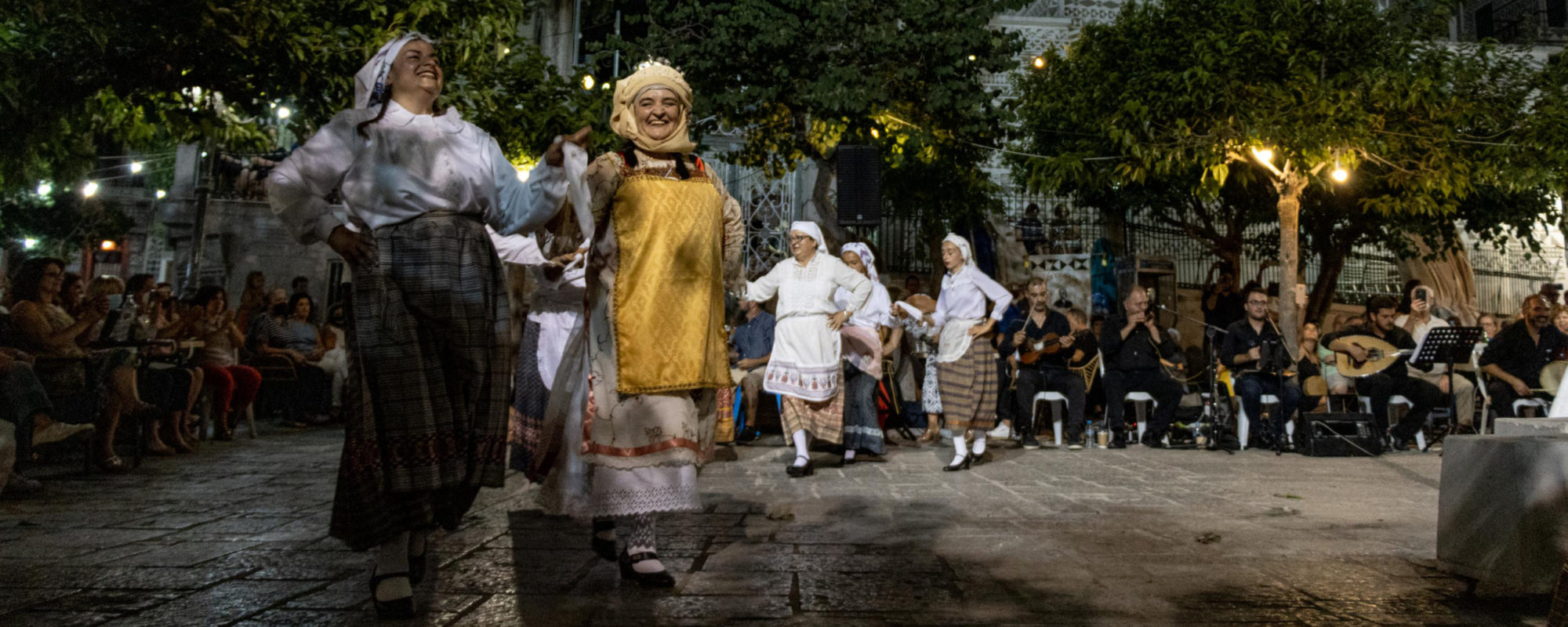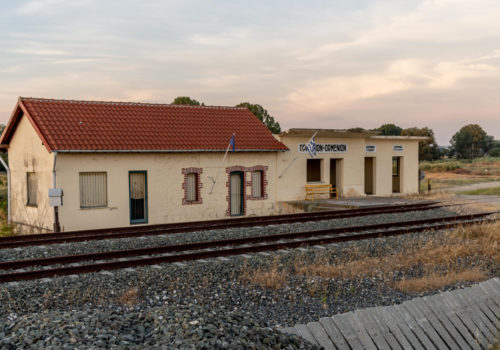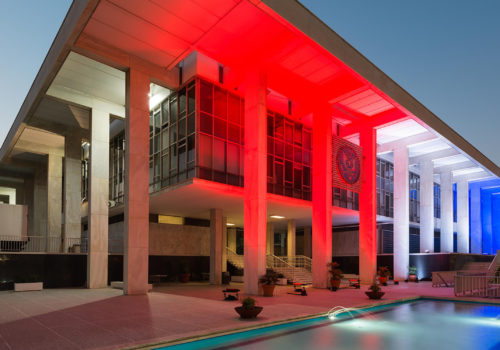OLYMPOI, Greece — Every morning before my first cup of tea, I load a tote bag with empty plastic water bottles and slip out of the house into a maze of narrow, twisting passages. The high stone walls of neighboring houses prevent sunlight from reaching the street, providing refuge from the summer heat. I walk under archways scented with cigarette smoke and grilled meat, through dim vaulted corridors lined with drying laundry, until I reach the nearest public fountain at Kato Porta or “Lower Gate,” which until 1821 was the sole entrance to the medieval village.
On Chios, as on most Greek islands, drinking water is scarce. The red-handled stone fountains scattered throughout the village are the only source of potable water, and each has its quirks. I prefer the shaded one at Kato Porta, whose high pressure lets me fill my bottles quickly. The school fountain has filtered water but requires a trek across the village and sometimes attracts wasps. And the one at the bus stop draws from a well; its water is used only for agriculture.
Performing this daily ritual has made me conscious of the water I consume. I check my supply before cooking pasta or boiling tea, and I keep a bottle in the fridge to bring with me to the beach. Before leaving home, I estimate how many bottles I’ll need to make it through the day.
I took water for granted when I lived on the mainland and could drink from any tap. During ten months in the northeastern port of Alexandroupoli, I enjoyed all the amenities of city life: powerful showerheads, high-speed internet, deliveries, bike lanes and dozens of shops and restaurants just down the street. Moving from one of Greece’s newest cities to this 13th-century fortress village on the northeastern Aegean island of Chios required some adjustment, highlighting the diversity of Greek landscapes and cultures along its Turkish border.
This place has a distinct character that locals alternately describe as conservative and cosmopolitan, a mentality that trading and seafaring Chians have carried beyond the island itself. “The people of Chios are crazy,” an Athenian journalist once told me after filming a documentary on the island. At midnight on Easter Sunday, two rival churches fire thousands of homemade rockets at each other during the annual rouketopólemos or “rocket war.” Earlier this year, residents also prevented a ship from unloading equipment to build a new migrant camp.
I spent my first weeks adapting to Olympoi’s rhythms, trying to understand my neighbors’ rhyming, rapid-fire dialect, and looking for ways to break into the tight-knit village community. Every time I go out to fill my bottles, I spin the roulette. You never know whom you’ll meet peeling vegetables outside their houses, roaring down the cobbled street on a motorcycle or taking coffee in the square. As I integrate into village life, I’ve discovered that community on this island is like drinking water: relatively difficult to find and for that reason, more precious.
An island of many fragrances
At 842 square kilometers, Chios sits like a severed ear off Turkey’s western coast, 3.5 nautical miles away at its nearest point. It is often called myrovólos, the “fragrant” island, because of the unique native plants that fill its air with their scents: sweet citrus orchards within the walled villas of Kambos, jasmine, rose, oregano, thyme and the resin-weeping mastic trees that thrive exclusively in the dry south.
The many aromas reflect a rich collage of images, terrain and architectures. For Akis Kokkinos, founder and director of the Chios-based contemporary art organization DEO Projects, one of the island’s strengths is that it can’t be summed up in a single image. “It’s not like a Cycladic island where you can see a postcard and say, ‘This is Mykonos, this is Santorini, this is Paros,’” he said of those popular tourist destinations.
Indeed, many locals describe Greece’s fifth largest island as three islands in one: a green, mountainous north, home to seamen and wealthy shipowners; the bustling port town of Chios and the fertile plain of Kampos in the middle; and the 24 Mastichochoria, or “mastic villages,” in the south, of which Olympoi is one. This warm, arid region is the world’s only source of mastic, a tasty, healthful resin secreted by the mastic tree (formally Pistacia lentiscus var. chia, or schínos in Greek). I will explore mastic production in my next dispatch.
Kokkinos is tall and lean with short-cropped hair and a regal aspect. As a child, he spent every summer in southeastern Chios. It was a place of revelation and catharsis for him. “I have this romanticized image of the island, which helps give me the motivation and energy to do a project here,” he said. “I think it would be different if I grew up here or was living here permanently.”
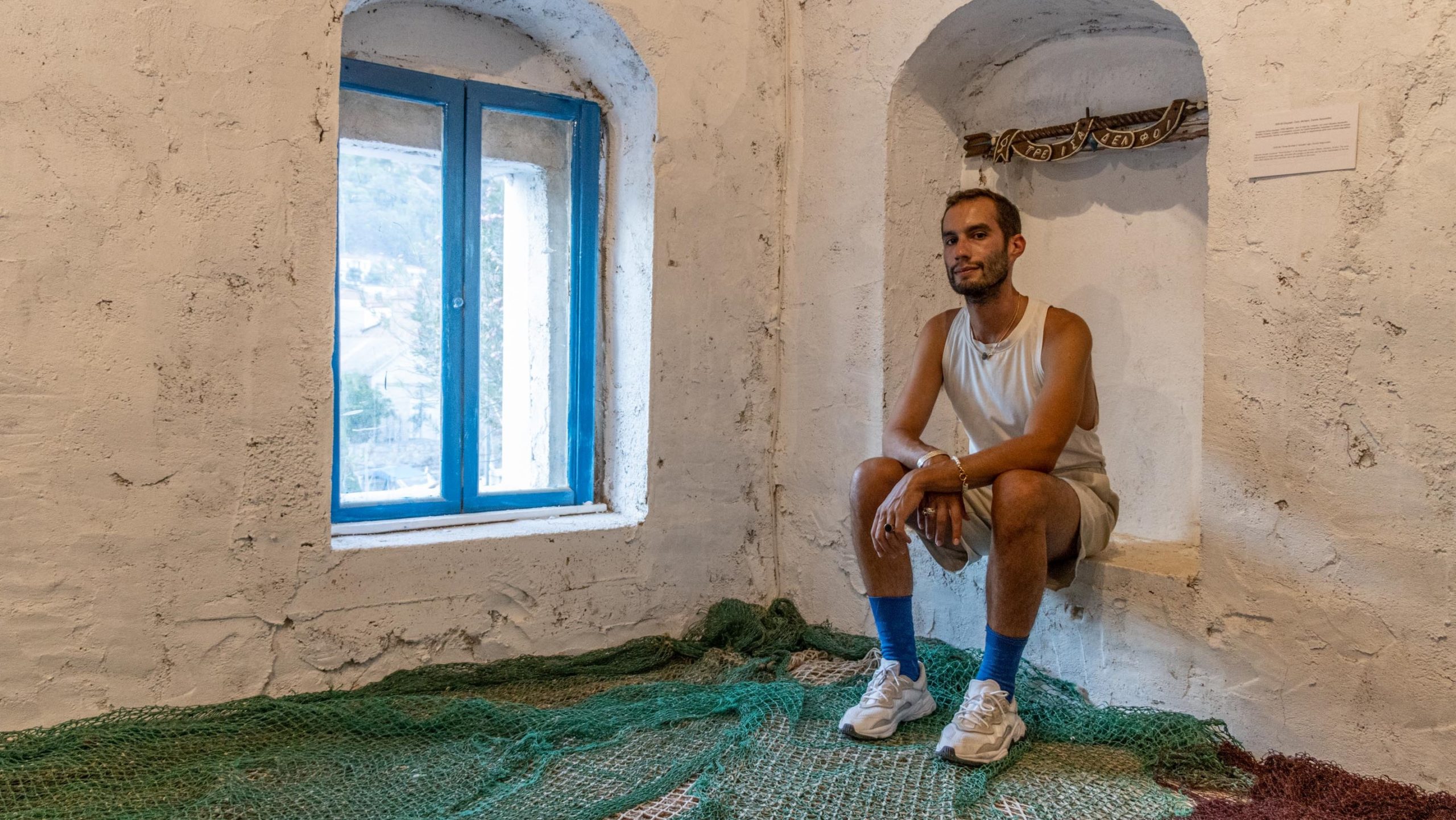
Now in its second year, DEO Projects presented a slate of performances and installations reflecting Chios’s long maritime tradition. Set in locations across the island, they were intended to “activate” historical spaces that have been closed or forgotten and give them “new roots,” Kokkinos told me.
We sat on a bench outside the “Seamanship of Lagkada” Cultural Space, a white, two-story building in the northern village of Lagkada beside a canal with small, docked boats. Open to the public for the first time this summer, the space hosted material and oral testimonies related to the village’s seafaring history as well as a new exhibit by Serapis Maritime, a floor installation of tangled teal, beige and maroon fishing nets called Palimpsest 2. The frayed, corroded nets bunched on the floor like a vast web, catching my foot more than once as I examined the items on display. “The point is to make a critique, but at the same time, we want people to come together, not apart,” Kokkinos said. “We want to tell a different aspect of the truth and somehow make space for that truth in the existing narrative.”
The “nomadic aspect” of DEO Projects helps it engage the island’s diverse populations. “Apart from the locals, there are so many other communities that coexist within the island, either temporarily or permanently, which makes the social web very multilayered,” he said. His thick, silver rings caught the sun as he rolled and lit a cigarette.
It’s these communities I want to investigate over the next six months. In addition to the mastic producers in fortified settlements like Olympoi, whose lives and traditions revolve around the cycles of the schínos tree, I plan to explore the island’s maritime tradition and track Chian shipowners’ contributions to Greek merchant shipping. I also want to learn what remains of the citrus industry that flourished in Kampos from the 14th to 19th centuries.
The island’s proximity to Asia Minor brought its people profit and pain. Chios was historically one of the most important trade and transit centers in the Eastern Mediterranean, receiving special privileges for its production of the valuable mastic gum. In 1822, during the Greek Revolution, Ottoman troops slaughtered some 42,000 islanders, over a third of the population, drawing international outrage and inspiring Eugene Delacroix’s 1824 painting Scenes from the Chios massacres: Greek families awaiting death or slavery.
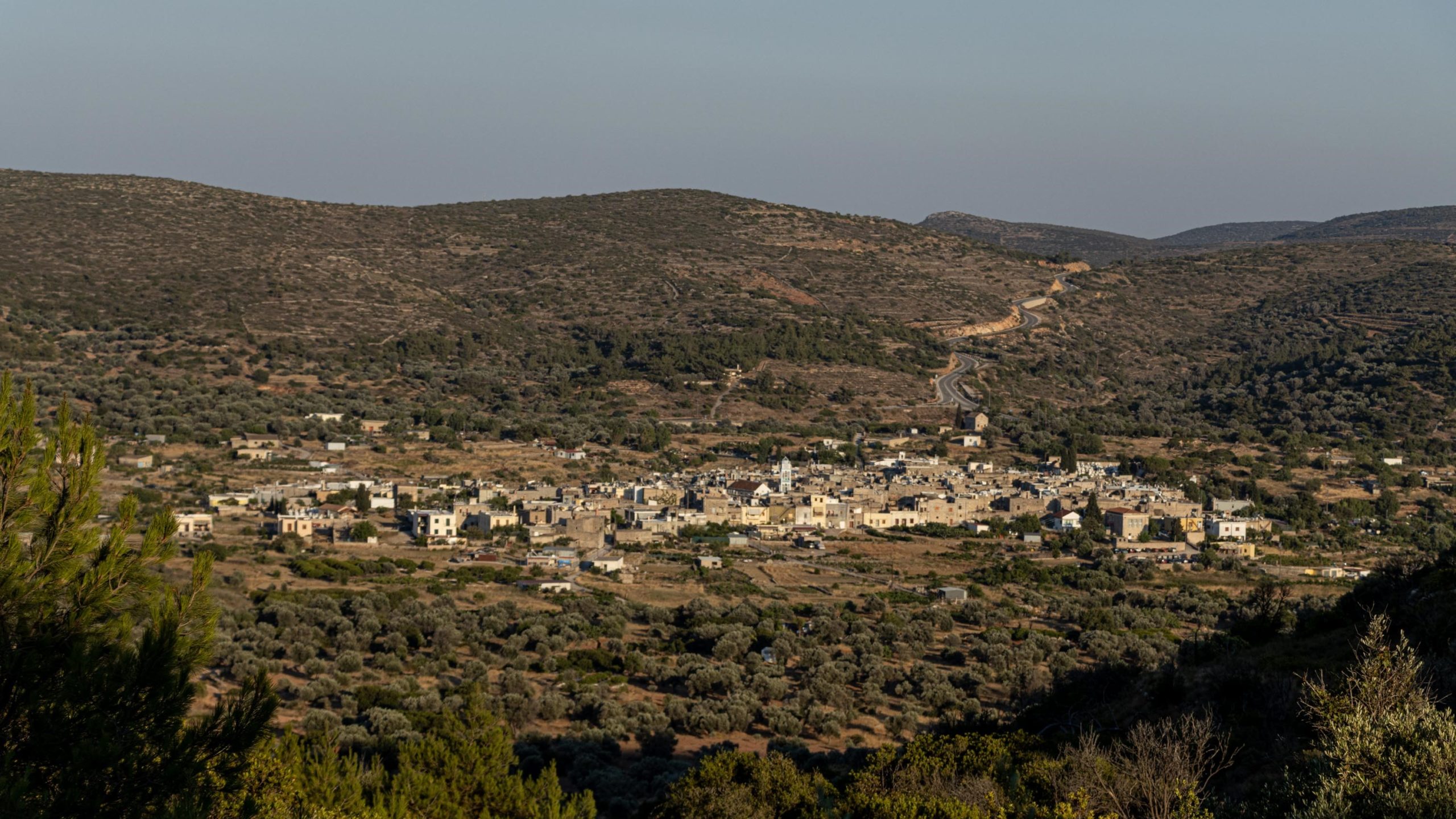
Since the 1922 Asia Minor Catastrophe, when Turkish forces captured and burned the city of Smyrna (present-day Izmir), Chios has also been a refugee hotspot. Tensions between the two countries flared again this summer when Turkish officials depicted Chios and other Greek islands as Turkish territory and President Recep Tayyip Erdogan warned Greek officials not to forget Izmir, threatening to “come down suddenly” on Greece. I will write about the current state of Greek-Turkish relations and the waves of migration sweeping through the island since 2015. Finally, I’m interested in the Chios diaspora in London, New York and other cities, and I’ve spoken with many returning Greeks to better understand their relationship to the island.
Chios has a special place in my heart because some of my oldest Greek friends hosted me here in August 2017. My partner Andreas’s family is also from Chios, and he spent his summers swimming in southern beaches like Vroulidia and Agia Dynami and slurping on a mastic-flavored “submarine” sweet in Pyrgi’s central square. Smell is an important sense for him, linked to his childhood memories of the island’s many aromas. Living on Chios is an opportunity for me to understand him better.
Mastichochoria’s defensive architecture
My first summer in Chios, I stayed in Olympoi with Maria Papanikolaou, an Athens-based visual artist and fellow Fulbrighter whose uncle Thanasis painstakingly renovated a two-story house in the traditional village style. It is made of local beige, slate and orange stone, and the exposed walls on the ground floor have built-in niches holding artifacts Thanasis collected from all over Greece. The walls of the interior stairway and second-floor sitting room are painted a calming periwinkle blue, while the vaulted bedrooms are sunny yellow.
Those architectural elements originally served a defensive purpose. In the 13th century, the Genoese Maona company, which organized and controlled mastic production, built villages like Olympoi to house mastic-growing serfs. The settlements consist of a square, central tower surrounded by a maze-like warren of stone houses. The façades of the outermost houses form a rectangular wall with a turret at each corner. The village gate opened early in the morning and closed at dusk to defend against pirates. Narrow, labyrinthine streets confused invaders but also prevented residents from gathering and revolting. After three months here, I still sometimes get lost in the winding streets and even pass my own door if I’m not paying attention.
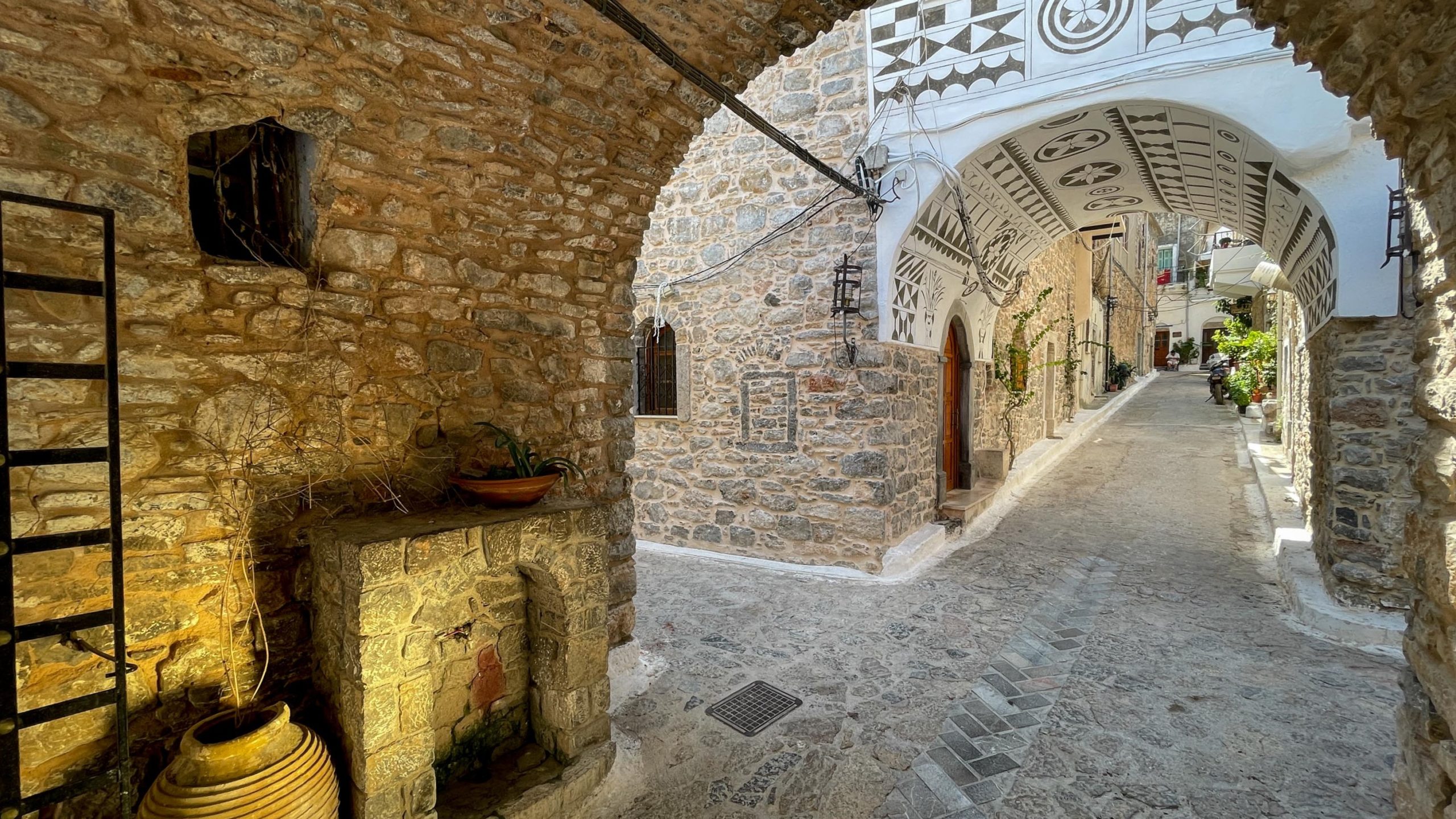
Houses are packed tightly together, often sharing walls and connected by arches or enclosed passageways called diavatiká. The cool ground floors of each house served as storerooms and stables, while the living quarters and kitchens occupied the second floor. In Maria’s house, the stone staircase leads to an atrium that connects the upper rooms and allows air and light to circulate. A ladder provides access to a roof terrace. All the rooftops are flat and roughly the same height, which enabled residents to move from house to house during an attack.
Olympoi survived the 1881 earthquake that devastated most of the island. Gradually, secondary entrances were opened in the defensive wall, the central tower was partly demolished for building material and houses sprang up outside the original walls of the settlement.
Today, the village is home to some 150 permanent residents. I had thought Alexandroupoli, a city of roughly 60,000 residents, was small, but here in Olympoi, not only does everyone know each other, but they’re often related as well. My neighbor Christina Koutelakis, a Greek American who has lived here for 24 years, said she can tell who passes her house by their cough or the sound of their walk. Here, as in the Evros village of Dadia, rumors run rampant. This summer, villagers speculated that Maria was moving here permanently and I am the father of her blond-haired daughter.
Mastichochoria’s defensive architecture contributes to Chios’s reputation as a closed society. “All the villages were constructed far from the sea because of piracy,” Kokkinos said, and that wariness of strangers remains rooted in the villagers’ mindset. Seafaring Chians lived in similarly “closed, protected” groups aboard ships that were difficult for outsiders to access, Kokkinos told me. “Hospitality in Chios was never a thing.” Because of the many industries here, the island didn’t turn to mass tourism as other Greek islands did in the 1980s. “So it’s a very raw, very secretive place,” he said. “You need to actually make an effort to be included, which is very hard, but also to understand how the island operates and works socially.”
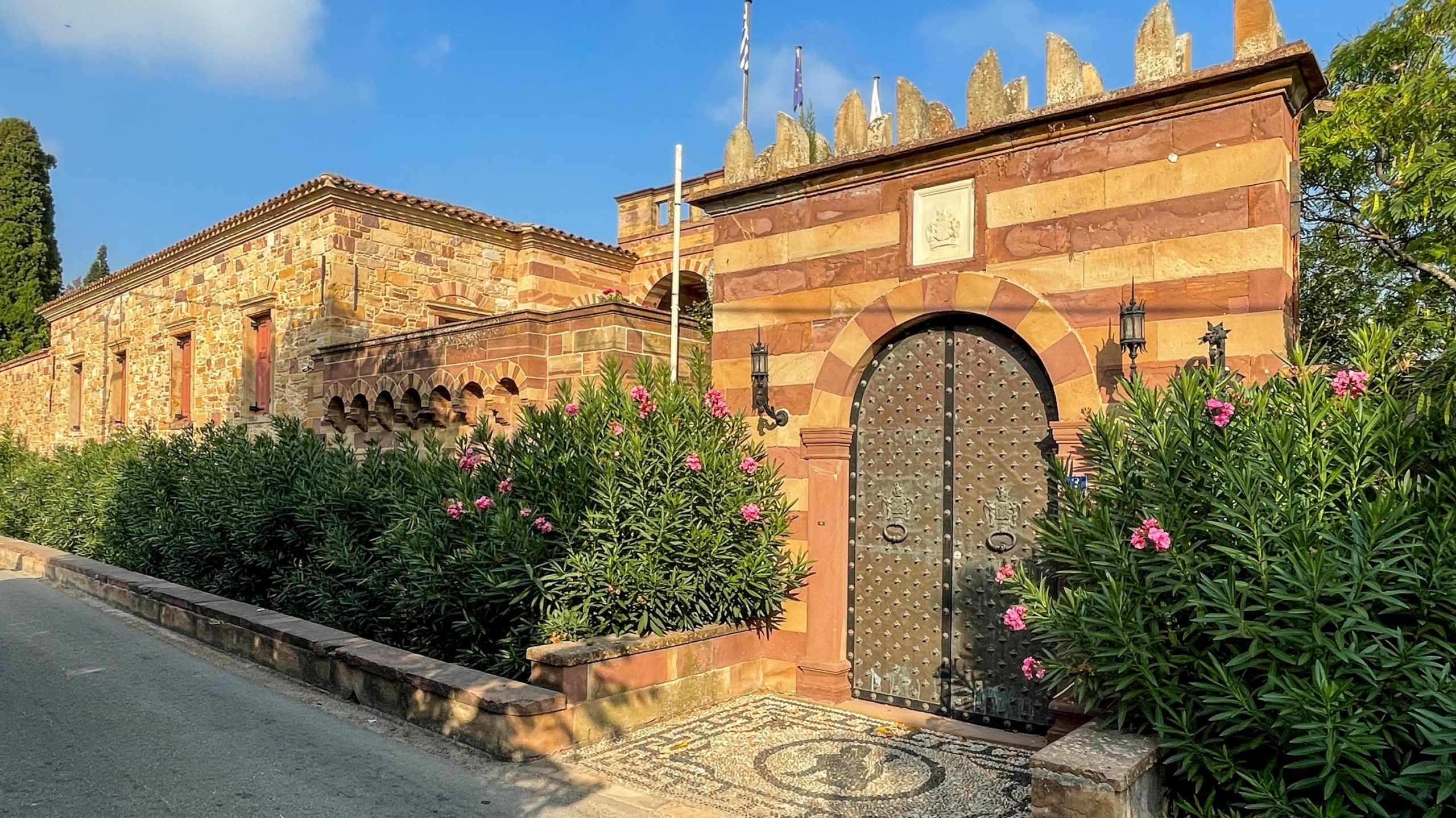
For tour guide Thomas Karamouslis, the apparent contradictions in Chian character can be traced back to the Genoese, who controlled the island for more than two centuries. Not only do the medieval villages in Italy’s northwest Liguria region—of which Genoa is the capital—resemble Mastichochoria, he says, but they also have the same mentality.
Like the Genoese, Chians aren’t ostentatious with their wealth. “They’re very hospitable and will do anything for their guests but they don’t waste anything,” Karamouslis told me. “Their homes don’t seem wealthy from the outside but inside they’re palaces.” That perfectly describes Kampos, where Genoese aristocrats planted citrus orchards and built country estates. Tall walls of rust-colored local stone hide the spacious mansions and protect the citrus trees from the wind. Today, the main road from Chios town to Mastichochoria winds through these high-walled estates, many of which have been abandoned or turned into guesthouses.
Summer returnees
Summers on Chios are simply magical. During my first visit to the island in 2017, we grilled steaks in the back alley of Maria’s house, fanning the flames with a hairdryer as sparks flew out of the grill and swirled around us. We spent our days eating fried dough balls called loukoumádes in the village square, swimming and reading at a friend’s laid-back canteen overlooking Apothika beach, and gathering ripe figs.
This summer, I’ve been surprised by the wealth of cultural events on the island. In one week, I attended an outdoor screening of Maria Douza’s film The Tree and the Swing in Komi, a mastic festival in Patrika, the launch of Stratis Vogiatzis’s new photography book in Kampos, a jazz concert at the Mastic Museum in Pyrgi and a night hike on Mount Aipos during the full moon.
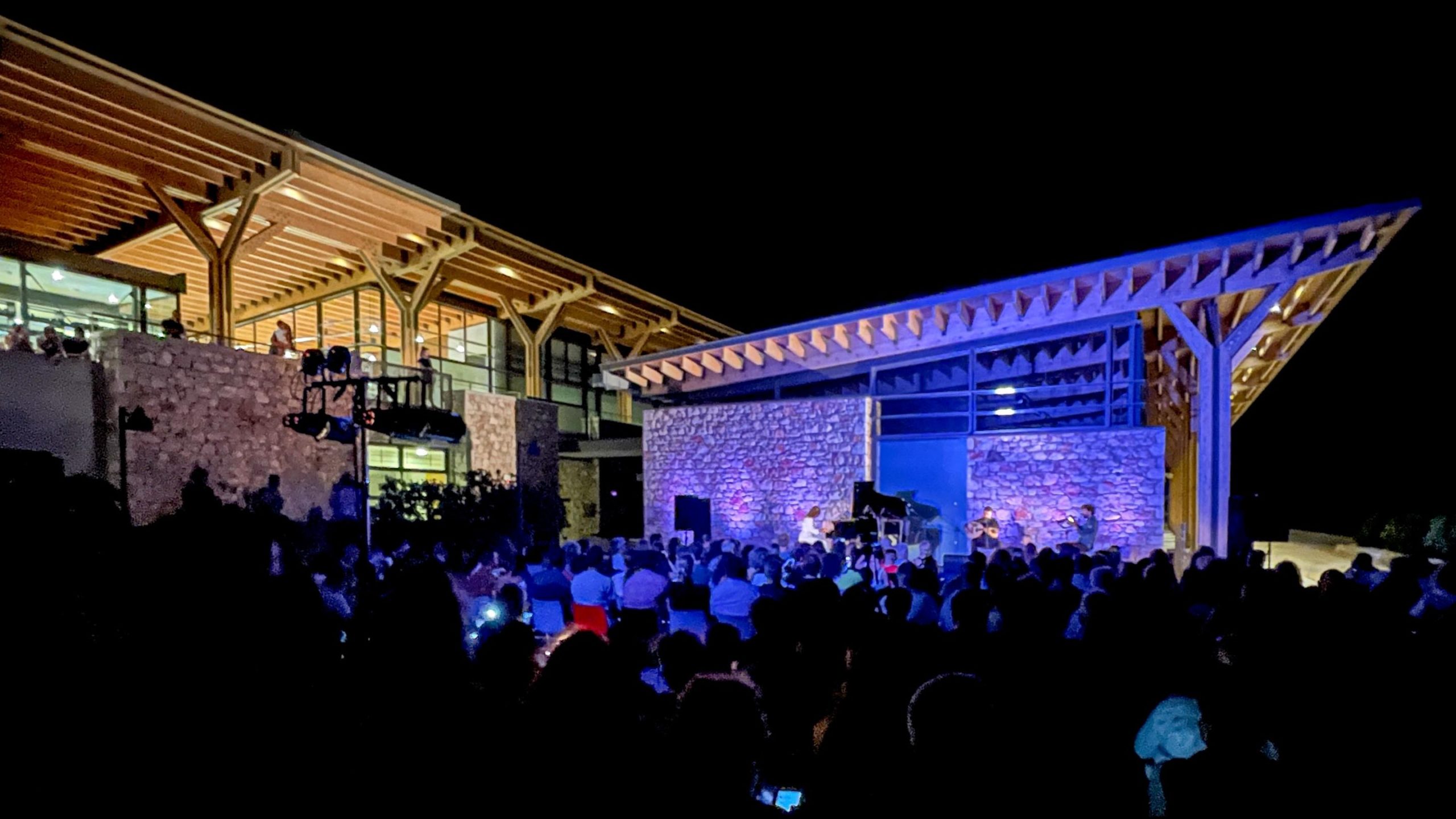
In addition, almost every other night there was a panigíri, a summer festival in honor of a saint where villagers eat, drink and dance to live music all night long. Panigíria were put on hold for two years during the Covid pandemic, so for many people—especially those who live abroad and couldn’t visit their villages—they offer a much-needed release.
On August 19, the Cultural Association of Olympoi organized a panigíri in the village schoolyard for all those who had returned for the summer. The yard was packed with tables. Maria and I hadn’t made a reservation beforehand, so the organizers created space for us near the meal preparation stations at a well they covered with a piece of cardboard. Dinner consisted of a Greek salad, a plate of cheese and bread and three sticks of souvlaki with French fries. Maria and her daughter danced with Greek-American children as trays of souvlaki flew to waiting tables. A woman carried her phone through the crowd so everyone could greet her mother on FaceTime.
The panigíri seemed to capture Olympoi’s—and by extension, Chios’s—global reach and special bond with its diaspora. “There are three times as many Chians as on Chios,” Karamouslis said, referring to the island’s far-flung inhabitants. “They’re always coming and going.” Unlike Evros, whose working-class inhabitants forged diaspora ties mostly with German factory towns, Chian merchants and seamen resettled in global trade centers like New York, London, Liverpool, Marseille, Odessa, Alexandria, Constantinople (now Istanbul) and Kolkata.
Many return each summer and support projects on the island. The New York philanthropist Michael Psaros, whose family hails from Olympoi, funded this year’s Greek America Corps on Chios, enabling 11 young people from the United States and Canada to spend three weeks volunteering on the island. Another Chios-connected organization, the London-based John S. Fafalios Foundation, supports the annual Chios Music Festival and Keos Magazine, which covers the people, places and history of the island, “aiming to connect the traveler to Chios.”
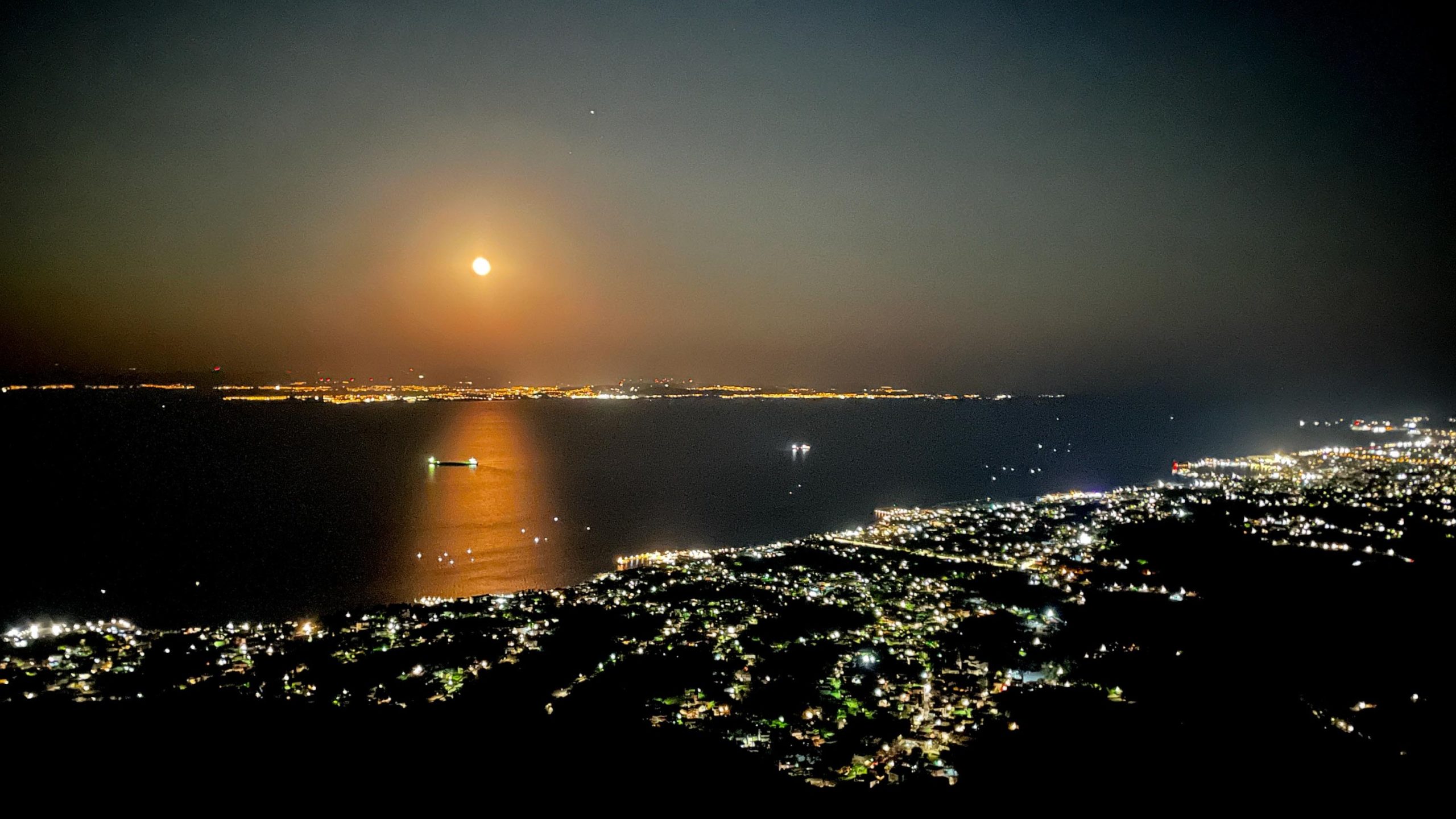
Tourism on the island was up this summer as Greeks from around the world returned for the first time since the onset of the Covid pandemic. And thanks to a slew of new investments, the number of visitors to the island is expected only to increase in the coming years. In March, the government allocated 2 million euros to promote tourism on the northeastern Aegean islands of Chios, Lesvos, Leros, Samos and Kos, which have borne the brunt of the refugee crisis. It also signed a 9.6 million euro contract to upgrade and expand the Chios airport.
But the huge communal gatherings started to take their toll toward the end of summer. A few days after August 15, the feast day of the Virgin Mary and one of the biggest holidays in Greece, I met my neighbor Christina filling her jug at Kato Porta. She told me that after a two-day celebration in Pyrgi, the next village over and currently a “Covid hot spot,” people in Olympoi were starting to get sick. That’s how I discovered another important function of the village fountains: as a meeting place where one can gather the latest information and gossip.
Becoming an Olympousis
When I arrived in Olympoi in July, I wondered how I could distinguish myself from the thousands of visitors who flood the island during the summer. I started getting to know the villagers slowly, striking up conversations with women sitting outside the pantopoleío, or grocery store, literally “a store that sells everything,” and writing with my front door open in the hope that curious neighbors would stop to say hello. My first visitor was a tourist filming the street with his phone. When he turned toward me, I waved an awkward hello.
As the weeks passed, I got used to unexpected “housemates”: millipedes curled on the stone steps, pillbugs scaling the walls, mosquitoes, omnipresent fruit flies and a bat hanging over my bedroom door. Andreas, who is always trying to scare my mother, told her there were venomous snakes on the island and scorpions living in the stone walls. I also grew accustomed to the village’s strange acoustics, how children shouting down the street or neighbors shuffling about next door sound like they’re coming from inside your house.
Since each house is unique and so unlike the ubiquitous 20th-century Greek apartment buildings called polykatoikíes, I leap at the chance to peek into other people’s homes. Stratis Vogiatzis did that for his book Inner World, photographing the interiors of Mastichochoria houses. In the afterword, he writes, “On entering the inner world of the Mastic Villages, I penetrated into a world where simplicity and tradition, tightly embraced for so many years, have influenced the inner reality of every home and have left their mark on the foundations of every room.
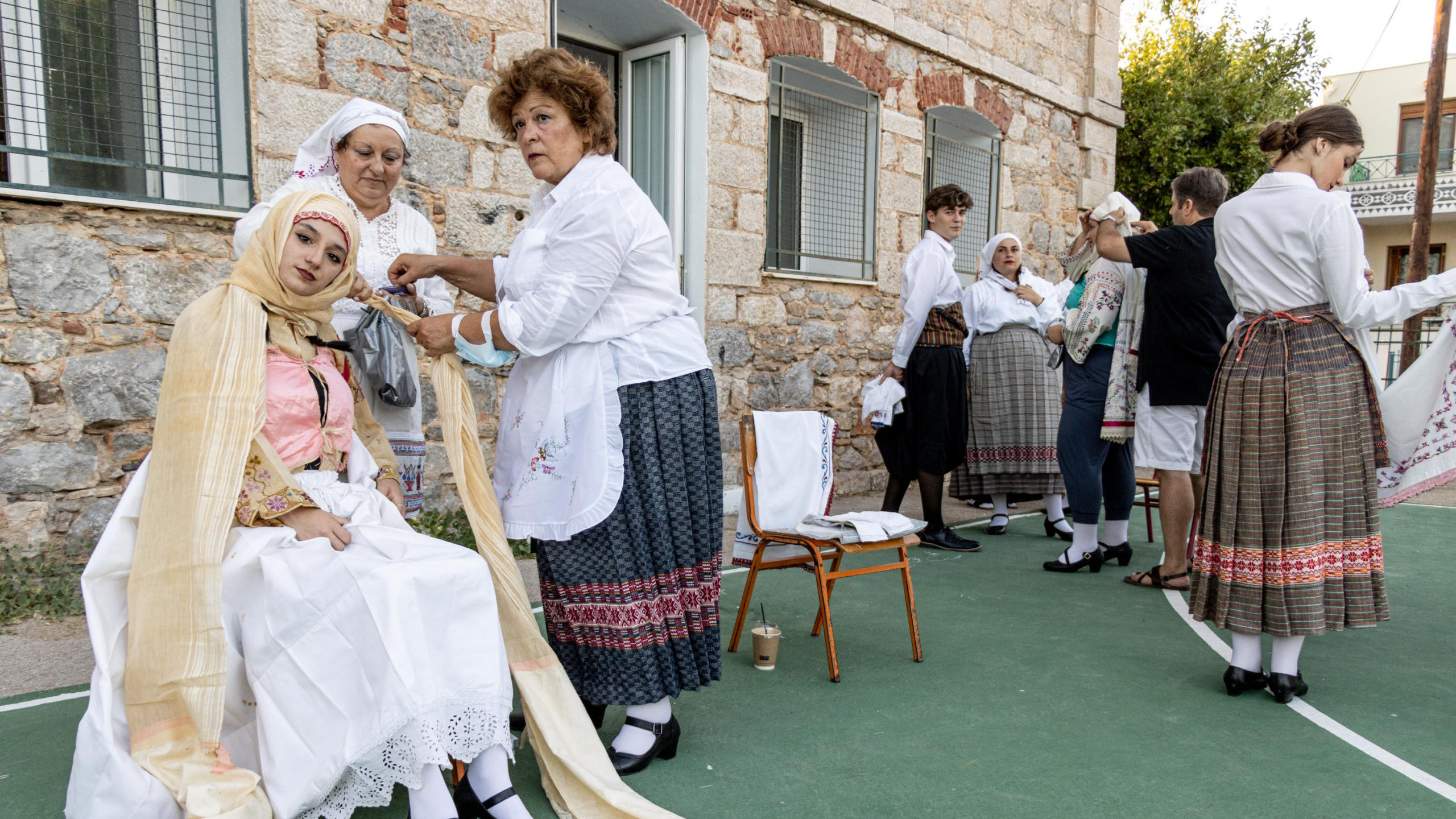
In early August, Olympoi’s dance group participated in “Carving the Tradition,” a night of traditional Greek dance in Pyrgi’s central square. Before the event, I photographed my neighbors putting on their traditional costumes outside the elementary school.
Most women wore everyday dress: a white shirt with lace trim, pleated skirt and apron with their hair tied in a white embroidered scarf. A few wore full bridal costumes, which include an elaborate headdress held in place by seven handmade metal pins and a stófa, an ornate, colorful cloth pinned to the chest. One woman told me that such bridal costumes cost thousands of euros to make today. Most are old family heirlooms, lovingly cared for and rarely washed.
I was gratified when Melpo Makkou, the owner of the pantopoleío, asked me to take a photo of the group and send it to her, and when Maria Tsetseri, a teacher who sometimes babysits Maria’s daughter, asked if I could drive back to Olympoi to fetch a book the association wanted to give the event’s organizers. It felt good to be depended on, to be of use in my new home.
When I returned to Pyrgi with the book, festive bouzouki and violin music echoed down the medieval streets. I squeezed through the crowd in the square and sat with Maria’s mother Alexandra, who treated me to souvlaki. We watched the Olympoi group dance before the Church of the Assumption of the Virgin, first in a long line, side by side with arms on each other’s shoulders, and then in pairs, each dancer holding the end of a handkerchief. Glancing around, I recognized familiar faces at nearby tables. The whole village had come out to support the dance group. “You’re becoming an Olympousis,” a local woman said warmly. Together, my neighbors and I cheered on the dancers, showing our village pride.
Top photo: The Olympoi dance group performs in Pyrgi

